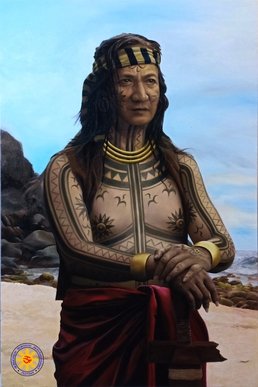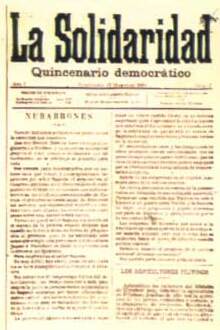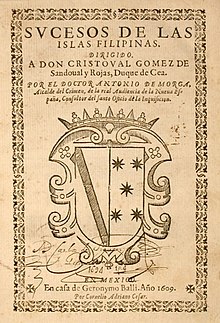
The Visayas, or the Visayan Islands, are one of the three principal geographical divisions of the Philippines, along with Luzon and Mindanao. Located in the central part of the archipelago, it consists of several islands, primarily surrounding the Visayan Sea, although the Visayas are also considered the northeast extremity of the entire Sulu Sea. Its inhabitants are predominantly the Visayan peoples.

Lapulapu or Lapu-Lapu, whose name was first recorded as Çilapulapu, was a datu (chief) of Mactan, an island now part of the Philippines. Lapulapu is known for the 1521 Battle of Mactan, where he and his men defeated Spanish forces led by Portuguese explorer Ferdinand Magellan and his native allies Rajah Humabon and Datu Zula. Magellan's death in battle ended his voyage of circumnavigation and delayed the Spanish occupation of the islands by over forty years until the expedition of Miguel López de Legazpi in 1564.

Bagoóng is a Philippine condiment partially or completely made of either fermented fish or krill or shrimp paste with salt. The fermentation process also produces fish sauce known as patís.

Datu is a title which denotes the rulers of numerous Indigenous peoples throughout the Philippine archipelago. The title is still used today, though not as much as early Philippine history. It is a cognate of ratu in several other Austronesian languages.

Ferdinand Johann Franz Blumentritt was an Austrian teacher, secondary school principal in Leitmeritz, lecturer, and author of articles and books about the Philippines and its ethnography. He is well known in the Philippines for his close friendship with the writer and Propagandist José Rizal, and the numerous correspondence between the two provide a vital reference for Rizal historians and scholars, including his last letter from prison before the execution.

Malate is a district of Manila, Philippines. Together with the district of Ermita, it serves as Manila's center for commerce and tourism.

Antonio de Morga Sánchez Garay was a Spanish soldier, lawyer and a high-ranking colonial official for 43 years, in the Philippines, New Spain and Peru, where he was president of the Real Audiencia for 20 years.
Pedro Chirino, SJ was a Spanish priest and historian who served as a Jesuit missionary in the Philippines. He is most remembered for his work, Relación de las Islas Filipinas (1604), one of the earliest works about the Philippines and its people that was written.
Philippine literature in Spanish is a body of literature made by Filipino writers in the Spanish language. Today, this corpus is the third largest in the whole corpus of Philippine literature. It is slightly larger than the Philippine literature in the vernacular languages. However, because of the very few additions to it in the past 30 years, it is expected that the former will soon overtake its rank.
Fray Casimiro Díaz Toledano OSA (1693–1746) was a Spanish Augustinian friar who accompanied the first Spanish expedition to the Cordillera, situated on the island of Luzon in the Philippines.

There have been several names of the Philippines in different cultures and at different times, usually in reference to specific island groups within the current archipelago. Even the name Philippines itself was originally intended to apply only to Leyte, Samar, and nearby islands. It was bestowed by the Spanish explorer Ruy López de Villalobos or one of his captains Bernardo de la Torre in 1543 in honor of the crown prince Philip, later Philip II. Mindanao, which they reached first and assumed to be the greater land, they named after the reigning emperor Charles V, who was also Spain's king Carlos I. Over the course of Spanish colonization, the name was eventually extended to cover the entire chain. It has survived with minor changes. The Philippine Revolution called its state the Philippine Republic. The US military and civilian occupations called their territory the Philippine Islands. During the Third Philippine Republic, the state's official name was formally changed to the Philippines.

La Solidaridad was an organization created in Spain on December 13, 1888. Composed of Filipino liberals exiled in 1872 and students attending Europe's universities, the organization aimed to increase Spanish awareness of the needs of its colony, the Philippines, and to propagate a closer relationship between the Philippines and Spain.

José Protasio Rizal Mercado y Alonso Realonda was a Filipino nationalist, writer and polymath active at the end of the Spanish colonial period of the Philippines. He is considered a national hero of the Philippines. An ophthalmologist by profession, Rizal became a writer and a key member of the Filipino Propaganda Movement, which advocated political reforms for the colony under Spain.
Tulì is a Filipino rite of male circumcision. It has a long historical tradition and is considered an obligatory rite of passage for males; those who have not undergone the ritual are ridiculed and labeled supót by their peers.
Mangubat is a Visayan, and old Tagalog word that means "to battle or combat".

Mangubat (Mang-gubat) ; is a Hispanic Filipino surname of Mactan Island origin which means " TO WAGE WAR " in Cebuano language.

The Rizal Monument in Daet, Camarines Norte was the first monument built to honor José Rizal, and is the oldest surviving such monument in the Philippines. It was designed by Lt. Colonel Antonio Sanz with the help of Ildefonso Alegre of the Philippine Revolutionary Army and through the financial contributions of the locals of Camarines Norte. The three-tiered stone pylon with its square base supporting a triangle in two stages was the first monument and memorial marker in memory of the Philippines' National Hero.

A folk legend holds that in October 1593 a soldier of the Spanish Empire was mysteriously transported from Manila in the Philippines to the Plaza Mayor in Mexico City. The soldier's claim to have come from the Philippines was disbelieved by the Mexicans until his account of the assassination of Gómez Pérez Dasmariñas was corroborated months later by the passengers of a ship which had crossed the Pacific Ocean with the news. Folklorist Thomas Allibone Janvier in 1908 described the legend as "current among all classes of the population of the City of Mexico". Twentieth-century paranormal investigators giving credence to the story have offered teleportation and alien abduction as explanations.

The term Paramount Ruler, or sometimes Paramount Datu, is a term used by historians to describe the highest ranking political authorities in the largest lowland polities or inter-polity alliance groups in early Philippine history, most notably those in Maynila, Tondo, Pangasinan, Cebu, Bohol, Butuan, Cotabato, and Sulu.

The historiography of the Philippines includes historical and archival research and writing on the history of the Philippine archipelago including the islands of Luzon, Visayas, and Mindanao.














